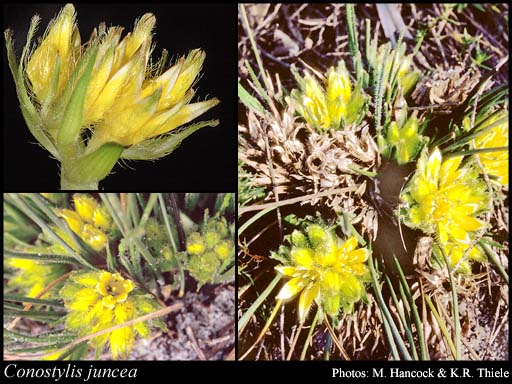- Reference
- Nov.Stirp.Dec. 3:19 (1839)
- Conservation Code
- Not threatened
- Naturalised Status
- Native to Western Australia
- Name Status
- Current
Rhizomatous, tufted perennial, grass-like or herb, 0.1-0.4 m high, inflorescences on short peduncles below leaves. Fl. yellow/green-yellow, Jul to Sep. White, grey or yellow sand.

Scientific Description
Leaves flat or elliptical (leaves compressed), 105-290 mm long, 0.5-6 mm wide; bristles or hairs on the leaf margin present, 1-1.5 mm long, with at least some small side branches at the base, flexuose and soft, angled towards the leaf apex; hairs on the surface of the leaf present. Scape present, hairy, 40-165 mm long. Inflorescence subtended by a bract 20-24 mm long, with several flowers; floral bracts 14-27 mm long; pedicels present, 2-3 mm long; flowers 15-17 mm long. Perianth hairy, radially symmetrical, uniformly coloured, yellow, with six more or less equal tepals, the inner segments 10-10.5 mm long. Stamens six, in one level; filaments 1.2-2 mm long; anther 5-6 mm long, without an appendage. Style 10-12 mm long. Flowers in July, August or September. Occurs in the Geraldton Sandplains, Swan Coastal Plain, Avon Wheatbelt and Jarrah Forest IBRA bioregion(s), of the South-west Botanical Province.
Distribution
- IBRA Regions
- Avon Wheatbelt, Geraldton Sandplains, Jarrah Forest, Swan Coastal Plain.
- IBRA Subregions
- Dandaragan Plateau, Katanning, Lesueur Sandplain, Northern Jarrah Forest, Perth.
- Local Government Areas (LGAs)
- Armadale, Bayswater, Canning, Chittering, Cockburn, Dandaragan, Gingin, Gosnells, Harvey, Kalamunda, Kwinana, Mandurah, Melville, Mundaring, Murray, Northam, Perth, Rockingham, Serpentine-Jarrahdale, South Perth, Stirling, Swan, Wanneroo, Waroona.